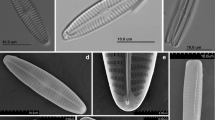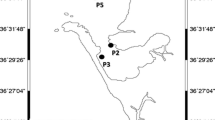Abstract
Routine bulk chemical characterization of sediments does not provide useful information on toxicity of sediment bound contaminants. This study reviewed and evaluated the utility of phytoplankton bioassays for evaluation of toxicity of sediment bound contaminants, including state-of-the-art techniques. Several techniques such as Algal Fractionation Bioassays, microcomputer-based toxicity testing and in situ bioassays including plankton cages have been developed and successfully applied in our research at various contaminated sites in the St. Lawrence Great Lakes. These bioassay techniques are sensitive, rapid and inexpensive for screening contaminants. The use and application of such techniques, based on bioavailability and physiological response of micro-organisms, are essential for the detection of environmental perturbations of an ecosystem. Such an early warning system will facilitate the preservation and rehabilitation of the Great Lakes.
Similar content being viewed by others
References
Ahlf, W., W. Calmano & U. Förstner, 1987. Correlation between chemical and biological evaluation procedures for the determination of trace-metal availability from suspended solids. Ect. Abstract, 3rd Symp. Sediment/Water, Geneva. pp. 140–143.
Dunnett, C. W., 1955. A multiple comparisons procedure for comparing several treatments with a control. J. Amer. Statist. Ass., 50: 1096–1121.
Flint, R. W. & G. J. Lorefice, 1978. Elutriate-primary productivity bioassays of dredge spoil disposal in Lake Erie. Water Resource. Res., 14(6): 1159–1163.
Förstner, U., 1987. An overview of scientific bases for developing remedial options. In R. L. Thomas, R. Evans, A. Hamilton, M. Munawar, T. Reynoldson, H. Sadar (Eds.). Proceedings of an International Workshop on Ecological Effects of In-Situ Sediment Contaminants. Hydrobiologia (in press).
Gannon, J. E. & A. M. Beeton, 1969. Studies on the effects of dredged materials from selected Great Lakes harbours on plankton and benthos. Center for Great Lakes Studies, Milwaukee, Wisconsin, Spec. Rept. No. 8.
International Joint Commission, 1974. Great Lakes Water Quality Agreement with annexes and texts and terms of reference, signed at Ottawa, April 15, 1972. United States and Canada, pp. 40.
International Joint Commission, 1977. Annual Report of the Water Quality Objectives Subcommittee and the Task Force on the Scientific Basis for Water Quality Criteria 1976. Appendix A to the Great Lakes Water Quality, International Joint Commission, Windsor, Ontario. 83 pp.
Jensen, A., B. Rystad & L. Skoglund, 1972. The use of dialysis culture in phytoplankton studies. J. Exp. Mar. Biol. Ecol., 8: 241–248.
Lind, O. T. & R. S. Campbell, 1969. Comments on the use of liquid scintillation for routine determination of14C activity in production studies. Limnol. Oceanogr. 14: 787–789.
Mayfield, C. I., 1984. A simple computer-based video image analysis system and potential applications to microbiology. J. Microb. Method. 3: 61–67.
Mayfield, C. I. & M. Munawar, 1983a. Preliminary study of the effects of contaminants from sediments on algal membranes. J. Great Lakes Res. 9(2): 314–316.
Mayfield, C. I. & M. Munawar, 1983b. (Abstract) Video digitization and fluorometry of algal cells with a microcomputer. Presented at the Symposium ‘Phycology in the World of High Technology’, Annual Meeting of the Phycological Society of America, American Institute of Biological Sciences, Grand Forks, N. Dakota.
Mayfield, C. I. & M. Munawar, 1987. Microcomputer-based measurement of algal fluorescence as a potential indicator of environmental contamination. Bull. Environ. Toxicol. (in press).
Munawar, M. 1982. Toxicity studies on natural phytoplankton assemblages by means of fractionation bioassays. Can. Tech. Rep. Fish. Aquat. Sci., 1152. (i–iv): 1–17.
Munawar, M. & S. Daniels, 1986. (Abstract). Resin treatment for segregating sediment-bound organic and metal toxicity to ultraplankton. Poster presentation ASM/CSM Symposium ‘Environmental Insult and Recovery of Stressed Systems’. U. of Toronto, June 1986.
Munawar, M. and G.L. Fahnenstiel. 1982. The abundance and significance of ultraplankton and micro-algae at an offshore station in central Lake Superior. Can. Tech. Rep. Fish. Aquat. Sci., 1153. (I–IV): 1–13.
Munawar, M., A. Mudroch, I. F. Munawar & R. L. Thomas, 1983. The impact of sediment-associated contaminants from the Niagara River mouth on various size assemblages of phytoplankton. J. Great Lakes Res. 9: 303–313.
Munawar, M. & I. F. Munawar, 1982. Phycological studies in Lakes Ontario, Erie, Huron and Superior. Can. J. Bot. 60: 1837–1858.
Munawar, M. & I. F. Munawar, 1984. (Abstract). Sensitivity o ultraplankton and picoplankton to contaminants and its ecological significance. Poster presentation at the annual meeting of American Society of Limnology and Oceanography. U. of British Columbia, Vancouver, June, 1984.
Munawar, M., I. F. Munawar, L. R. Culp & G. Dupuis, 1978. Relative importance of nannoplankton in Lake Superior phytoplankton biomass and community metabolism. In M. Munawar (Ed.) Limnology of Lake Superior. J. Great Lake Res. 4(3–4): 462–480.
Munawar, M., I. F. Munawar, W. P. Norwood & C. I. Mayfield 1987b. Significance of autotrophic picoplankton in the Great Lakes and their use as early indicators of contaminant stress. In M. Munawar (Ed.) Proc. Internat. Symp. of Phycology of Large Lakes of the World. Arch. Hydrobiol. Beih. Ergebn. Limnol. 25: 141–155.
Munawar, M., I. F. Munawar, P. E. Ross & A. Dagenais, 1982 Microscopic evidence of phytoplankton passing through glass-fibre filters and its implications for chlorophyll analysis. Arch. Hydrobiol. 94(4): 520–528.
Munawar, M., I. F. Munawar, P. E. Ross & C. I. Mayfield 1987a. Differential sensitivity of natural phytoplankton size assemblages to metal mixture toxicity. In M. Munawar (Ed.) Proc. Internat. Symp. on Phycology of Large Lakes of the World. Arch. Hydrobiol. Beih. Ergebn. Limnol. 25 123–139.
Munawar, M., P. Stadelmann & I. F. Munawar, 1974. Phytoplankton biomass, its species composition and primary production at a nearshore and mid-lake station of Lake Ontario during IFYGL. Proc. 17th Conf. Great Lakes Re: 629–652.
Munawar, M. & R. L. Thomas, 1984. Bioassessment of Toronto Toledo sediments. Report of the Dredging Subcommittee, International Joint Commission, Windsor, Ontario.
Munawar, M., R. L. Thomas, W. P. Norwood & S. A. Daniels, 1986. Sediment toxicity, and production-biomass relationships of size fractionated phytoplankton during on-site simulated dredging experiments in a contaminated pond. In P. Sly (Ed). Sediment/Water Interactions. Springer-Verlag Publishers. 407–426.
Munawar, M., R. L. Thomas, W. P. Norwood & A. Mudroch 1985. The toxicity of Detroit River sediment-bound contaminants to ultraplankton. J. Great Lakes Res. 11(3) 264–274.
Munawar, M., R. L. Thomas, H. Shear, P. McKee & A. Mudroch, 1984. An overview of sediment-associated contaminants and their bioassessment. Can Tech. Rep. Fish Aquat. Sci. 1253 (i–vi): 1–136.
Owens, O. V., P. Dresler, C. C. Crawford, M. A. Tyler & H. H. Seliger, 1977. Phytoplankton cages for the measurement in situ of the growth rates of mixed natural population. Chesa peak Science 18(4): 325–333.
Ross, P. E. & M. Munawar, 1981. Preference for nannoplanktor size fractions in Lake Ontario zooplankton grazing J. Great Lakes Res. 7(1): 65–67.
Ross, P. E. & M. Munawar, 1987. Zooplankton feeding rates at offshore stations with North American Great Lakes. In M. Munawar (Ed.) Proc. Internat. Symp. on Phycology of Large Lakes of the World. Arch. Hydrobiol. Beih. Ergebn. Limnol. 25: 157–164.
Sakshaug, E. & A. Jensen, 1978. The use of cage cultures in studies of the biochemistry and ecology of marine phytoplankton. Oceanogr. Mar. Biol. Ann. Rev. 16: 81–106.
Schultz, J. S. & P. Gerhardt, 1969. Dialysis culture of microorganisms: design, theory and results. Bacteriol. Rev. 33: 1–47.
Shuba, P. J.,, H. E. Tatem & J. H. Gentile, 1977. Guidance for performing liquid phase and suspended particulate phase phytoplankton bioassays. Appendix E. In U.S. Environ Prot. Agency/Corps Engin., Techn. Comm. Criteria Dredgec and Fill Material. Ecological Evaluation of Proposed Discharge of Dredged Material into Ocean Waters. Implementation Manual for Section 103 of Public Law 92–532, July 1977. Environm. Effects Lab., U.S. Army Engin., Waterway; Exper. Stat., Vickburg, Mississippi.
Strickland, J. D. H. & T. R. parsons, 1968. A practical handbook of seawater analysis. Bull. Fish. Res. Board. Can. 167 283–293.
Thomas, W. H., J. T. Hollibaugh, D. L. R. Seibert & G. T. Wallace, Jr., 1980. Toxicity of a mixture of ten metals to phytoplankton. Mar. Ecol. Prog. Ser. 2: 213–220.
United States Environmental Protection Agency/Corps of Engineers. Technical Committee on Criteria for Dredged and Fill Material 1977. Ecological Evaluation of Proposed Discharge of Dredged Material into Ocean Waters; Implementation Manual for Section 103 of Public Law 92–532 (Marine Protection, Research and Sanctuaries Act of 1972) (Second Printing, April 1978). Environm. Effects Lab., U.S. Army Engin. Waterways Exper. Stat., Vicksburg, Mississippi.
Utermöhl., H., 1958. Zur Vervolkommung der Quantitativen Phytoplankton Method. Mitt. Verein. Limnol. 9: 1–38.
Vollenweider, R. A., M. Munawar & P. Stadelmann, 1974. A comparative review of phytoplankton and primary production in the Laurentian Great Lakes. J. Fish. Res. Bd. Can. 31(5): 739–762.
Wong, P. T. S., Y. K. Chau & D. Patel, 1982. Physiological and biochemical responses of several freshwater algae to a mixture of metals. Chemosphere. 11(4): 367–376.
Author information
Authors and Affiliations
Rights and permissions
About this article
Cite this article
Munawar, M., Munawar, I.F. Phytoplankton bioassays for evaluating toxicity of in situ sediment contaminants. Hydrobiologia 149, 87–105 (1987). https://doi.org/10.1007/BF00048650
Issue Date:
DOI: https://doi.org/10.1007/BF00048650




